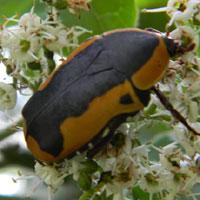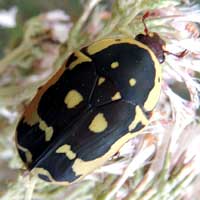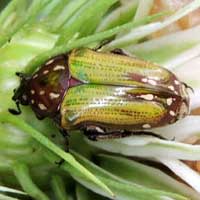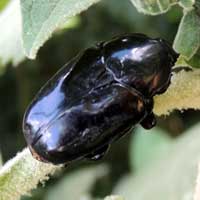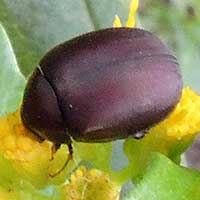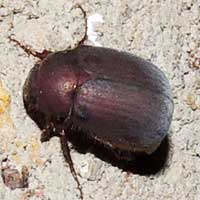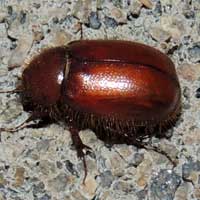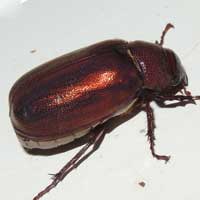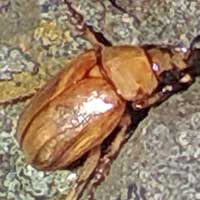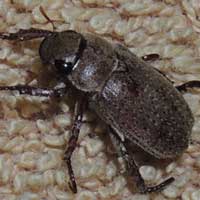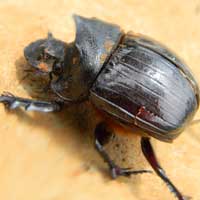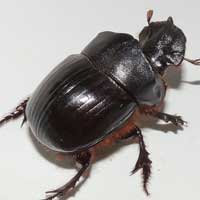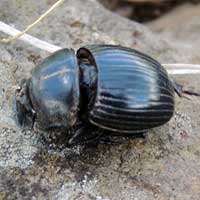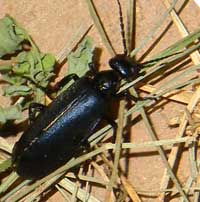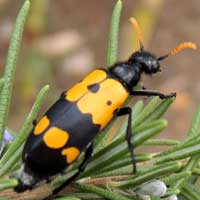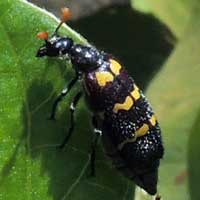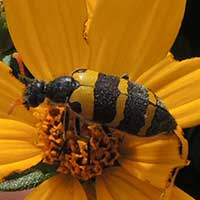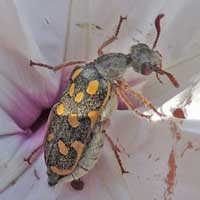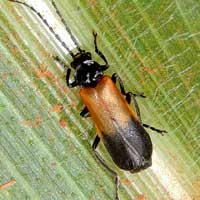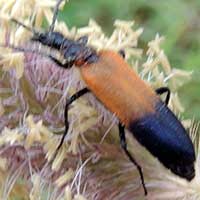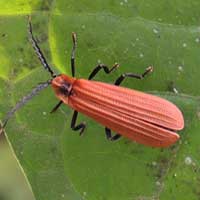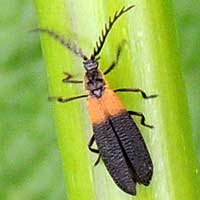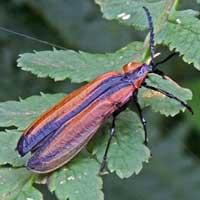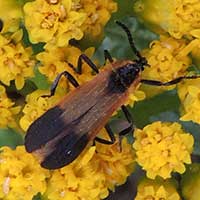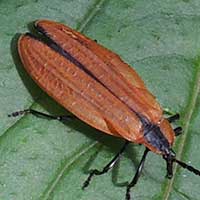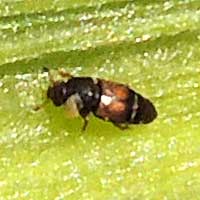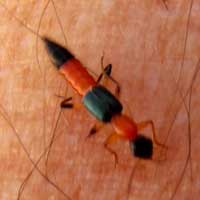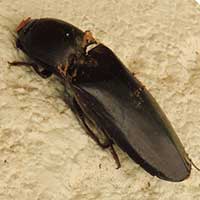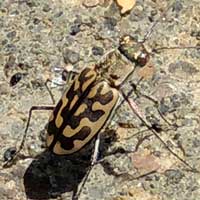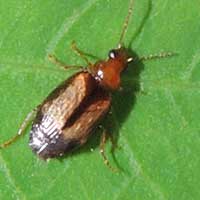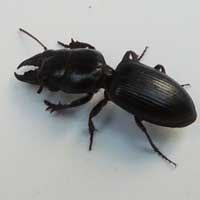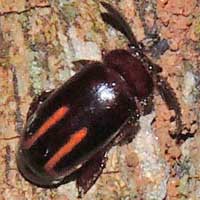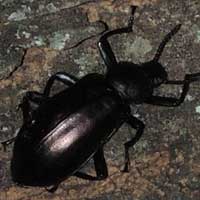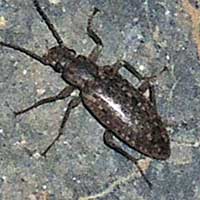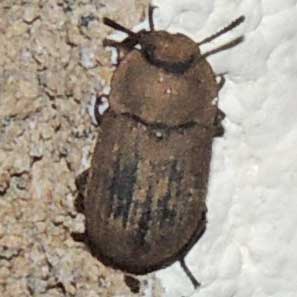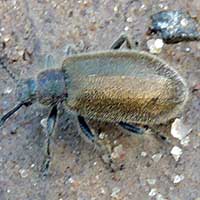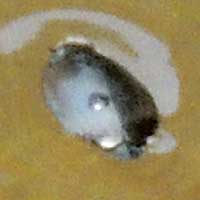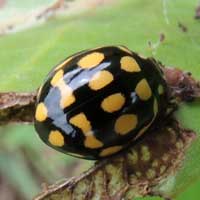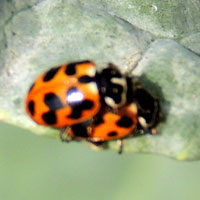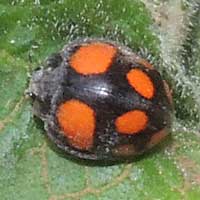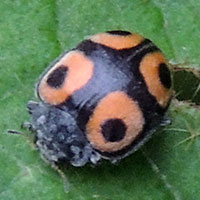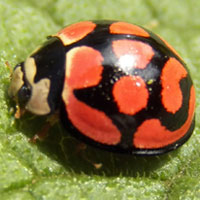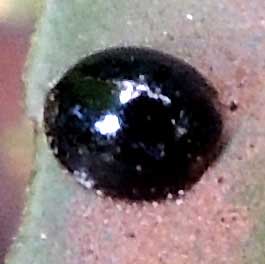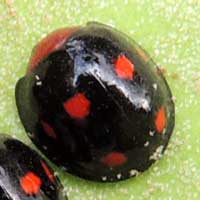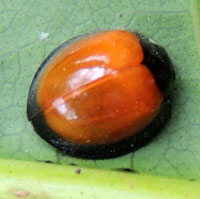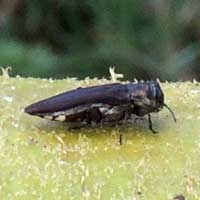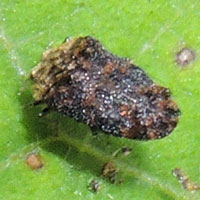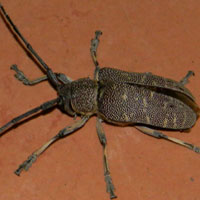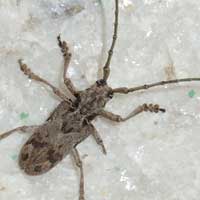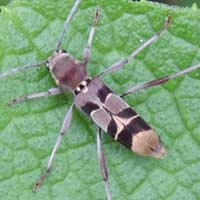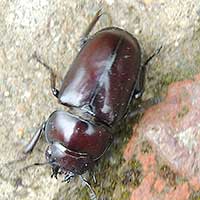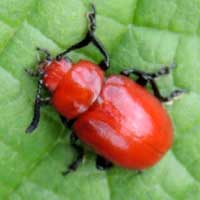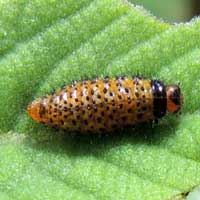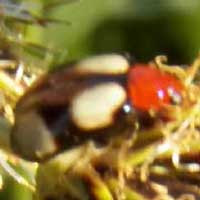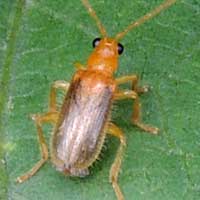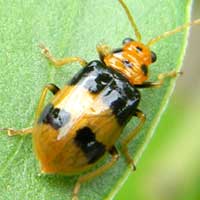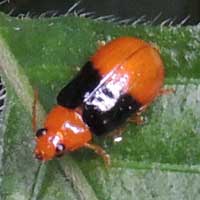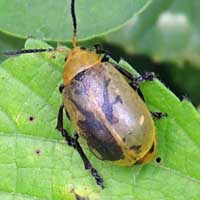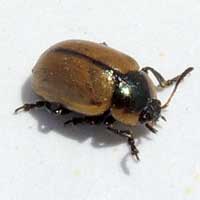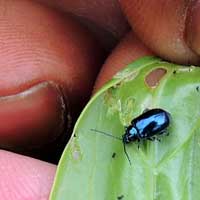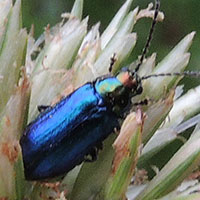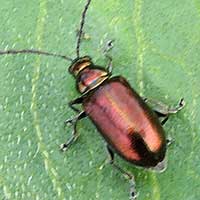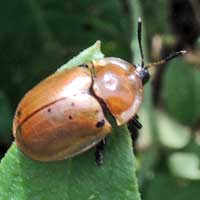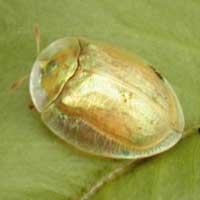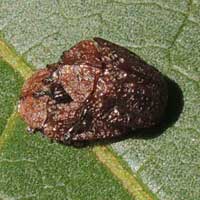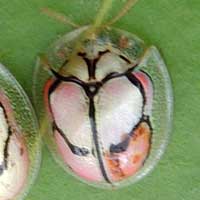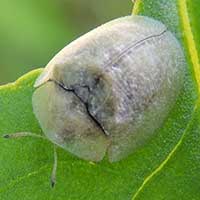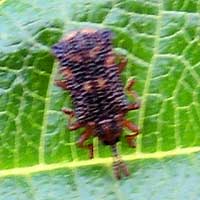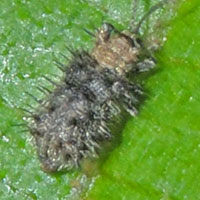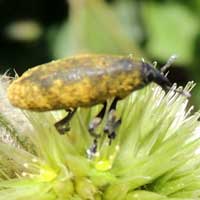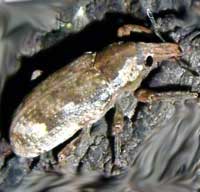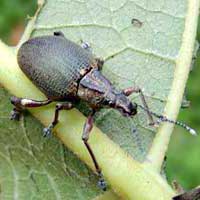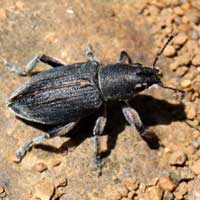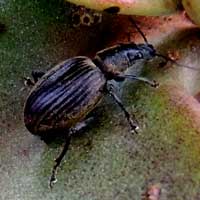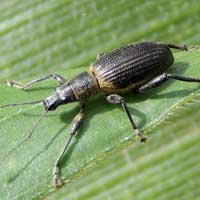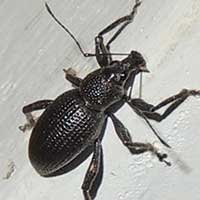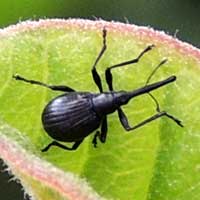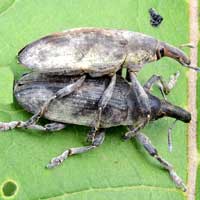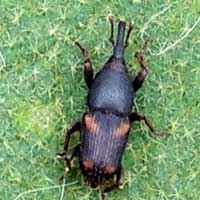Sharply marked large beetles with rather pointed prothorax and head. Conspicuous at flowers. Grubs live in soil.
Clings to and feeds on flowers. Bright yellow-and-black face-like pattern on elytra. Length 23 mm.
The beetle to the left is also a kind of chafer. Many Cetoniinae species in Kenya often found chewing flowers.
Glossy black beetle gnawing of foliage. The elytra have a distinct anterior depression and ridge.
Pollen and nectar are a nutritious food for pollinators and non-pollinators alike.
This may beetle has a unique color. The immature is a soil-inhabiting grub.
Many, many species of may beetles which often come to electric lights. This one has a fringe of long setae all around.
Minute pits arrayed over the surface of the elytra provides the adjective "Punctate". This one was seen at Kakamega Forest.
This relatively soft-shelled beetle was about 10mm long and had come to lights.
This nocturnal scarab beetle appears to have rather enlarged compound eyes.
Large dark brown or black beetles roll grazing animal dung into balls. Males have fabulous horns. This one is a female.
This dung beetle is an amazing earth moving machine.
Medium-sized dark brown or black beetles roll animal dung into balls. Notice the shovel-shaped head for digging.
Dark blue, almost black. Elytra (wing covers) soft. Pronotum narrower than head and wings. Seen often on flowers.
Gaudy black and yellow are clear warning signs about this insect's toxicity. Meloidae is the family of Blister Beetles.
This blister beetle with it's black and yellow bands may be part of a 'Mimicry Complex'.
Alternating orange and black bands suggest a wasp-like insect.
About twelve orange-yellow spots on the gray elytra. Found on or in flowers.
Long antennae. Elytra soft and leathery. Moves slowly on flowers or vegetation. Probably toxic.
Adult soldier beetles take it easy of flowers feeding on pollen. Bicolored black and orange. Slow moving.
Net-winged beetles have flexible, leathery elytra with intricate pattern of veins. Most are bright red, yellow or orange and are distasteful to birds.
This is a male as evidenced by the enlarged lamellae of the antennae. Bicolored black and orange. Slow moving.
This net-winged has a triangular pronotum and colors are blue-black and coppery. Found near Kapenguria
Similar to #2, perhaps genus Cladophorus. This one looks like it survived a bird attach.
This is a rather large example from Kakamega Forest.
Small beetles with clubbed antennae. Attracted to damaged fruit with yeast spoilage. This one is in maize.
Most rove beetles are much smaller than this one. Note the short elytra (wing covers) and slender shape.
The pronotum, the segment behind the head, has two sharp points at the posterior corners. Beetle 'clicks' when threatened.
Predatory and agile beetles have highly sophisticated eyes and favor open soil, often near water.
Driver ants helped me see this beetle as it was attempting escape.
Musculature for oversized mandibles enlarges the head of these predators.
Perhaps a not-so-common species that was seen at night. I got help with the id.
Glossy-black, flightless beetle releases foul liquid on being disturbed. Often takes a 'tail up' posture.
Nearly black, hard-cased beetle with both ends tapering to narrow points.
Grayish black beetle with very hard elytra. Tends to walk slowly along the ground. Semi-arid areas.
Bronze-brown over all and covered with setae (insect hairs). Crawls on ground and can spew smelly matterial.
The domain of these predatory beetles is the surface of ponds and slow streams where their spinning antics define them.
Sitting on exposed foliage near Turbo, Uasin Gishu, Kenya. Dec. 2015.
From 0 to 13 black spots on elytra. The pronotum is outlined in white with two central white spots. Eats aphids.
Sitting on exposed foliage at roadside in Gatamaiyo Forest, Gilgil, Kenya. Oct. 2016.
Some lady bird beetles feed on leaves as larvae and adults. This one has a striking pattern.
Many lady beetles are gaily colored and because many control pests important to man they are popular insects. This one can be orange or red with black spots.
Many other lady beetle species are smaller and mostly black or dark gray. Most require a microscope to ID to species.
Small, convex lady beetles, glossy black with red spots. Pronotum and head are dull red. Observed near Eldoret.
These colorful lady birds were resting on the lower surface mango leaves in the Rift Valley.
Between the stage of larva and the adult lady bird beetle is the pupa, which is immobile and attached to a plant.
Active beetles with keen eyesight often on surfaces of fallen tree limbs. Many, many kinds from small to large. Metallic sheen especially on underside.
Among the smallest Buprestidae, the metallic wood-boring beetles, developes as a larva within the layers of a leaf. The adults chew out small quantities of leaf. Usually rather host specific.
Robust beetles with long, stout antennae. Larvae tunnel inside tree branches.
Large species, about 20mm long. Long, heavy antennae. Elytra and prothorax marked with grey and black pattern.
Some small and medium-sized longhorns resembe bees or wasps and are diurnal.
Stout beetle with rich, wood-brown elytra and short, sharp mandibles. Kakamega Forest. Adult of wood-boring larva.
Fire-engine red leaf beetles feeding on leaves of Clerodendron. Likely toxic to birds. Legs black.
Yes, this is a beetle! Beetles have four life stages: 1-egg, 2-larva, 3-pupa, 4-adult. This one belongs the Fire-red Beetle.
Wide variety of often colorful beetles that eat leaves. Some can jump and are called flea beetles.
Some leaf beetles are called rootworm because the larva stage feeds upon plant roots.
Colorful, medium-sized beetles often seen chewing leaves.
The larvae of this group may be found skeletonizing plant leaves.
Another skeletonizing leaf beetle, but with rather drab coloration. The elytra are nearly transparent.
Sesbania is valued for its ability to fix nitrogen so this foliage-eater could be considered a pest.
There are many species of small blue-black leaf beetles. Look for holes chewed in leaf of specific plants. Some kinds can jump.
With enlarged hind legs some leaf beetles can jump away when threatened.
Irridescent bronzy beetle. Like many beetles, it's capable of flying to escape.
Rusty-orange, convex leaf beetle from Nairobi National Park.
Gold colored with tortoise-like shell. Often seen on Beach Morning Glory along Indian Ocean coast.
This mating pair resemble fecal pellets of a large caterpillar - a ploy to avoid being eaten.
Intricately marked with black lines on pearly elytra. Larvae and adults feed on foliage of morning glories (Convolvulaceae) and were found in Kajiado.
Tortoise beetles are leaf beetles, i.e. their food is leaves. This one is also on morningglory.
Dorsally compressed beetle with bumpy texture. Brought in from America to control lantana.
This leaf-mining leaf beetle is covered with prickly spines, probably a deterrent to insect eating birds.
This weevil is mottled yellow green and black, is about 8mm long and is on Cyathula (Amaranthaceae).
Thousands of kinds of weevils inhabit farms, forests and grasslands of Kenya. Many have larvae (grubs) that live under the soil.
Wide snout with mothparts at end. Textured and striated elytra are ashy gray. Adults chew on green foliage.
Crawling along on heavly grazed ground west of Eldoret.
Nearly black broad-nosed weevil found feeding on leaves of Kalanchoe in the Rift Valley highlands.
Adult beetles create holes in maize leaves that are tender and unfurled.
This shiny black weevil has numerous rows of minute black pits (punctate) on its pronotum and elytra.
This weevil is small, about 3mm. It is on a leaf of Cordia africana, a tree-sized borage.
Large weevils, about 22 mm. Feeding on leaves of Vernonia, perhaps the larval host as well.
Small dark brown beetles that bore into grains like corn or sorghum. Wings allow insects to disperse.
